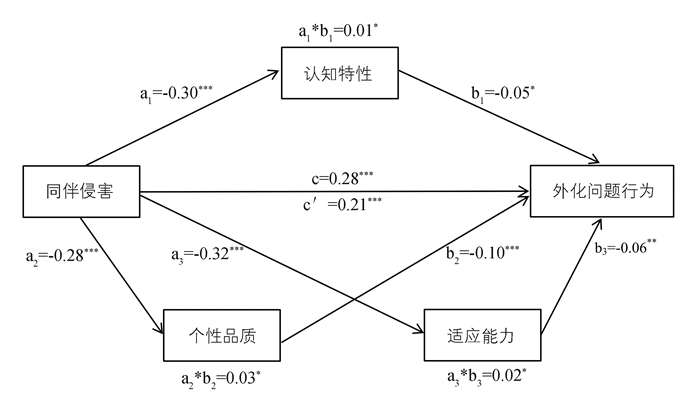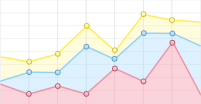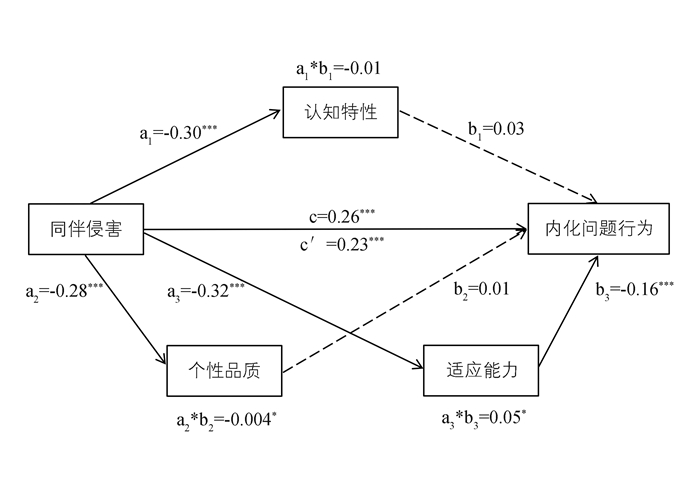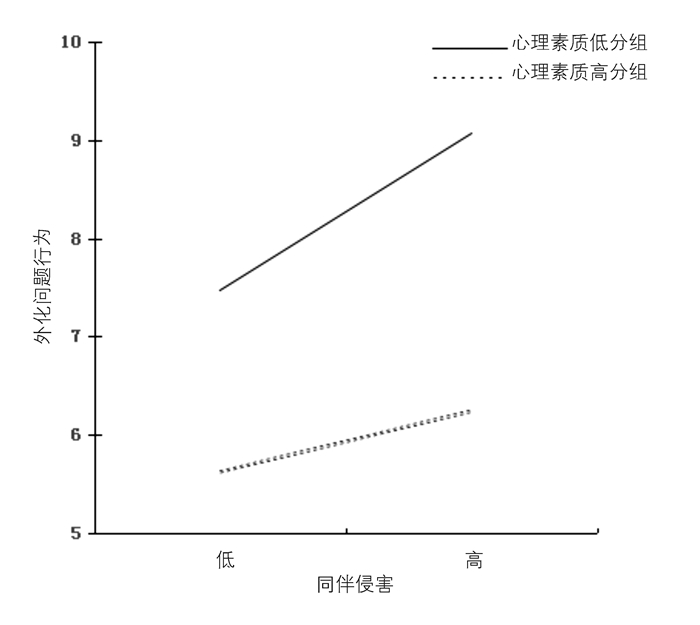HTML
-
同伴侵害(peer victimization)是一种在世界范围内引起普遍关注的社会现象[1]。近年来,相关报道时常见诸报端,引起社会各界的关注并逐步成为社会热点问题。同伴侵害是故意的、重复的伤害身体或心理较弱个体的攻击行为[2],主要包括身体侵害(physical victimization)、言语侵害(verbal victimization)、关系侵害(relational victimization)和网络侵害(cyber victimization)等类型[3]。大量研究表明,同伴侵害会对青少年的身心健康产生极为消极的影响[4-5],其与内化问题行为及外化问题行为密切相关。其中,内化问题行为是内部指向的(inner-direct)、在个体内部形成的不安、紧张和痛苦等,外化问题行为则是外部指向的(outer-direct)、违背社会规则的、造成人际矛盾冲突并产生不适结果的行为[6]。同伴侵害是内化及外化问题行为的风险因素,它们既有即时性联系,也存在长期效应[7]。目前,有关青少年同伴侵害负面影响的研究已较为详尽。然而,针对缓冲或抵消同伴侵害不利影响的保护性因素方面的研究较少[8]。有研究表明,不同类型的支持(如同伴支持、教师支持及父母支持等)[9-10]以及学校归属感[8, 11]可缓冲同伴侵害的不利影响。除此之外,青少年自身的保护性因素也可起到缓冲作用,心理素质是其重要内容。
张大均等将心理素质界定为:以生理条件为基础的,将外在获得的刺激内化成稳定的、基本的、内隐的,并具有基础、衍生、发展和自组织功能的,并与人的适应-发展-创造行为密切联系的心理品质[12-13]。心理素质可参与到个体心理活动的各个方面,对个体的心理健康、社会适应及行为习惯等产生影响。心理素质作用机制亚模型认为,外界致病风险因素通过个体内在的心理素质起作用[14]。有研究表明,心理素质能显著负向预测个体的问题行为[15],也可缓冲负性事件对个体的消极影响,使其在发展过程中适应良好,表现出较低的抑郁水平和孤独感水平[16-17]。
作为严重的负性事件,同伴侵害很可能对青少年心理素质发展产生不利影响,进而使其表现出更多的内化及外化问题行为。换句话说,即同伴侵害可对内化及外化问题行为产生直接影响,也可通过心理素质产生间接影响。由此,本研究提出第一个假设:心理素质在同伴侵害和内化及外化问题行为间起中介作用。
尽管同伴侵害经历对青少年的身心健康产生消极的影响,但也并非有此经历的青少年都会出现相同程度的内化及外化问题行为。同伴侵害对内化及外化问题行为的影响可能因青少年心理素质水平的差异而有所不同。本研究根据两种假设(压力缓冲假设和压力易损假设)来探讨心理素质的调节作用。依照压力缓冲假设,心理素质可缓冲同伴侵害的不利影响,高心理素质水平的青少年从低同伴侵害情境到高同伴侵害情境会出现相对较少的内化及外化问题行为,而低心理素质水平的青少年在同样情况下其内化及外化问题行为则会急剧增加。压力易损性假设认为心理素质在高同伴侵害情境会失去其缓冲作用,即不同心理素质水平的青少年在内化及外化问题行为上的差异只表现在低同伴侵害情境下,在高同伴侵害情境下高心理素质水平青少年的优势将不复存在。以上两种假说中,心理素质均能调节同伴侵害与内化及外化问题行为的关系,故提出第二个假设:心理素质调节同伴侵害和内化及外化问题行为间的关系。
中介效应假设认为同伴侵害可通过对青少年心理素质的作用进而影响内化及外化问题行为;调节效应假设认为心理素质在高同伴侵害情境下对内化及外化问题行为的缓冲作用可能存在(压力缓冲假设),也可能消失(压力易损假设)。检验心理素质中介作用的目的在于解释同伴侵害不利影响的具体路径,检验调节作用的目的在于探讨其不利影响是否会因个体心理素质水平的不同而有所不同。
综上,本研究重点探讨心理素质在同伴侵害和内化及外化问题行为间所起作用的具体机制,分别对其中介和调节作用进行检验。以进一步拓展心理素质作用机制方面的研究,为后续的预防及干预工作提供理论基础。
-
采用整群随机抽样从我国西南地区5所中学(从初一到高二)选取若干班级进行团体施测。共发放问卷2 316份,获得有效问卷2 011份,有效回收率86.83%。其中初一471人(23.4%),初二323人(16.1%),初三268人(13.3%),高一491人(24.4%),高二458人(22.8%);男生1 016人(50.5%),平均年龄14.90±1.63岁,女生995人(49.5%),平均年龄14.92±1.58岁。
-
运用张文新等(1999)修订的Olweus儿童欺负问卷(Olweus Bully/Victim Questionnaire, OBVQ)(初中版)中的6个条目来考察同伴侵害的状况,包括言语欺负、关系欺负和身体欺负[18]。问卷采用1(没发生过)~5(一周好几次)5级评分,分数越高说明受侵害程度越高。若被试在某个题项上的得分大于或等于3(一个月两到三次),即被划分为受欺负者[19]。该问卷有良好的信效度[20]。本研究中该问卷的Cronbach's α系数为0.75。
-
采用Goodman(1997)编制的长处和困难问卷(Strengths and Difficulties Questionnaires, SDQ)(学生版)[21]。该问卷有25个题项,包括情绪因子、品行因子、多动因子、同伴因子和亲社会因子。问卷采用0(不符合)~2(完全符合)3级评分。根据已有研究,将该问卷的品行因子和多动因子作为外化问题行为指标,将情绪因子和同伴因子作为内化问题行为指标[22-23],该问卷有良好的信效度[24]。本研究中的内化及外化问题行为的Cronbach's α系数分别为0.78和0.67。
-
采用胡天强等(2017)修订的中学生心理素质问卷(Psychological Suzhi Questionnaire for Adolescents, PSQAS)(简化版)[25]。该问卷有24个题项,包括认知特性、个性品质和适应能力三个维度。问卷采用1(非常不符合)~5(非常符合)5级评分,得分越高表示心理素质越好。该问卷有良好的信效度[26-27]。本研究中该问卷的Cronbach's α系数为0.93,三个维度的Cronbach's α系数分别为0.87、0.85和0.83。
-
运用SPSS22.0和SPSS Process宏程序进行数据的分析处理。
-
采用Harman单因子检验方法对共同方法偏差进行分析,未旋转的主成分因素分析结果表明,特征根大于1的因子有8个,最大的因子解释的变异量为21.36%,小于40%的临界标准,即不存在明显的共同方法偏差。
一. 研究对象
二. 测量工具
1. Olweus儿童欺负问卷(初中版)
2. 长处和困难问卷(学生版)
3. 中学生心理素质问卷(简化版)
三. 数据分析
四. 共同方法偏差的检验
-
以同伴侵害、心理素质、内化及外化问题行为为因变量,以性别和年龄段(初中、高中)为自变量分别进行独立样本t检验。结果如表 1所示,同伴侵害的性别差异及年龄段差异显著,男生的同伴侵害高于女生,初中生的同伴侵害高于高中生;心理素质和内化问题行为的年龄段差异显著,初中生心理素质得分及内化问题行为高于高中生;外化问题行为的性别差异显著,男生外化问题行为高于女生。从效应量Cohen's d值来看,初中生和高中生,及男生和女生的同伴侵害具有实际的差异(0.2<d<0.5)。
-
如表 2所示,Pearson积差相关分析结果表明,同伴侵害、心理素质、内化及外化问题行为间相关皆显著。其中,同伴侵害与内化及外化问题行为皆呈显著正相关,心理素质则与这三者呈显著负相关。
-
为检验心理素质在同伴侵害和内化及外化问题行为间的中介效应,采用偏差校正百分位Bootstrap中介效应检验法进行分析[28]。以同伴侵害为预测变量,年龄段和性别为控制变量,内化及外化问题行为为结果变量,重复取样次数设定为5 000次,估计中介效应的95%置信区间(CI),若该区间不包含0则意味中介效应显著,反之亦然。
结果发现,心理素质在同伴侵害和内化及外化问题行为间存在显著的中介效应。具体而言,心理素质在同伴侵害和外化问题行为间起部分中介效应,95%置信区间为[0.05,0.08],中介效应值为0.06,占总效应的22.25%;心理素质在同伴侵害和内化问题行为间起部分中介效应,95%置信区间为[0.19,0.43],中介效应值为0.03,占总效应的11.15%。
心理素质各维度间存在密切联系,但功能作用有所不同,故对其各维度的多重中介效应进行检验。结果如图 1所示,心理素质三个维度在同伴侵害和外化问题行为间的中介效应均显著,认知特性(a1*b1=0.01,SE=0.01,95% CI=[0.004,0.03]),个性品质(a2*b2=0.03,SE=0.01,95% CI=[0.01,0.05]),适应能力(a3*b3=0.02,SE=0.01,95% CI=[0.01,0.03])。进一步对三者中介效应值进行差异检验,发现差异均不显著。
如图 2所示,适应能力在同伴侵害和内化问题行为间的中介效应显著(a3*b3=0.05,SE=0.01,95% CI=[0.03,0.07]),而认知特性(a1*b1=-0.01,SE=0.01,95% CI=[-0.02,0.01])和个性品质(a2*b2=-0.004,SE=0.01,95% CI=[-0.02,0.01])的中介效应不显著。进一步对三者中介效应值进行差异检验,结果发现,认知特性与适应能力(效应值=-0.06,95% CI=[-0.02,0.01]),及个性品质与适应能力(效应值=-0.003,95% CI=[-0.05,0.01])的中介效应差异分别显著,即心理素质各维度在同伴侵害影响内化问题行为的过程中适应能力的作用最大。
-
采用层次回归分析对心理素质在同伴侵害和内化及外化问题行为间的调节效应进行检验。先将性别及年龄段等人口学变量转为虚拟变量,并根据已有研究[29],对同伴侵害和心理素质进行中心化处理,生成同伴侵害与心理素质的乘积项。
如表 3所示,在控制年龄段及性别的作用后,同伴侵害和心理素质可分别显著正向和负向预测内化及外化问题行为,两者的交互项对外化问题行为有显著的预测作用(β=0.05,p<0.05),对内化问题行为则无显著预测效应(β≈0,p>0.05)。为更清楚地揭示心理素质调节作用的实质,进行简单斜率检验,对心理素质进行分组(Z≧1SD为高分组,Z≦-1SD为低分组)。结果如图 3所示:随着同伴侵害程度的加深,心理素质高分组抑或低分组的外化问题行为均有增加。具体来说,对低分组而言,这种增加趋势更加明显(β=0.30,p<0.01),对高分组而言增加趋势则相对平缓(β=0.07,p>0.05),即心理素质可以缓冲同伴侵害对青少年外化问题行为的不良影响。
一. 各变量的性别及年龄段差异
二. 各变量的描述性统计与相关分析
三. 心理素质的中介效应检验
四. 心理素质的调节效应检验
-
研究考察了青少年同伴侵害和内化及外化问题行为的关系。结果发现,同伴侵害与二者呈显著正相关,这与已有研究结果一致[4]。此外,男生在同伴侵害与外化问题行为上显著高于女生,在内化问题行为上则无显著差异。即相对于女生而言,男生中存在更普遍的同伴侵害现象,及攻击行为和违纪行为等,这与已有研究结果一致[30-31],也比较符合现实的情况。有研究发现,青少年在内化问题行为上的性别差异不显著[32]。初中生在同伴侵害及内化问题行为上均显著高于高中生,这反映了不同年龄的发展差异。如有研究表明同伴侵害的风险在童年晚期呈上升趋势,在初中阶段最高,在高中阶段呈下降趋势[33],这可能与个体逐渐成熟以及社会化进程有关[34]。从同伴侵害的年龄差异来看,初中生卷入同伴侵害的风险更高[30]。这应引起政策制定者、教育主管部门及学生家长的更多关注,同伴侵害的预防和干预工作应将初中生作为重中之重。
-
大量研究表明,同伴侵害对青少年的身心健康产生极为消极的影响,但其起作用的过程往往离不开青少年自身因素的影响。本研究针对同伴侵害和心理素质对青少年内化及外化问题行为的联合影响,检验了心理素质的中介和调节效应模型。
首先,心理素质的中介效应假设得到了支持,同伴侵害可通过降低心理素质的功能作用,进而对内化及外化问题行为产生不利影响,这为张大均等提出的心理素质作用机制亚模型提供了证据支持[35]。对心理素质各维度多重中介作用的检验发现,认知特性、个性品质和适应能力三个维度在同伴侵害和外化问题行为间的中介作用均显著,这与外化问题行为的特点有关,其主要表现为行为层面的攻击、违纪等,易被教育者察觉并进行相应的教育规劝与惩处矫正。与之相对应,内化问题行为则是形成于个体内部,对他人不造成直接威胁,也较难为教师、同学及学生家长等所察觉,主要表现为情绪层面的抑郁、焦虑和社交孤立等[6]。在同伴侵害与内化问题行为之间,仅适应能力的中介作用显著。适应能力被认为是心理素质结构中最能体现衍生功能的因素[13, 35],其功能作用在于对个体内在心理过程进行控制、理解和调适,对外在社会环境进行学习、应对和防御,是一种使自身与环境和谐协调的能力,同伴侵害通过对适应能力的调节间接影响内化问题行为。
其次,心理素质的调节效应得到部分证实,结果部分支持压力缓冲假设,这也为张大均等认为心理素质可调节外在致病风险因素影响个体心理健康水平的观点提供了证据支持[35]。心理素质作为个体重要的保护性因素,相当于调节器,与同伴侵害的交互作用能够削弱同伴侵害对青少年外化问题行为的不良影响。心理素质低分组在高同伴侵害情境下外化问题行为急剧增加,而高分组在同样情境下外化问题行为增加的幅度则相对平缓。这意味着心理素质应在青少年同伴侵害的预防及干预工作中起到重要的作用。
需要指出的是,心理素质的中介效应与调节效应并非相互排斥,而是从不同角度对同伴侵害和外化问题行为的关系进行了阐释。中介效应表明同伴侵害通过心理素质间接影响外化问题行为,调节效应则表明同伴侵害与外化问题行为的关系强度随个体心理素质水平的不同而有所不同。
本研究亦存在一些局限之处有待改进。首先,本研究仅用自我报告法收集同伴侵害的状况,未来研究应采用多种方法(同伴提名、教师评定及家长报告)收集资料以减少共同方法偏差及社会赞许性效应等。其次,本研究属于横断研究,不能做出因果关系的推论,今后宜采用追踪研究进一步探索心理素质作用的实质并对青少年同伴侵害开展着实有效的预防及干预工作。









 DownLoad:
DownLoad: